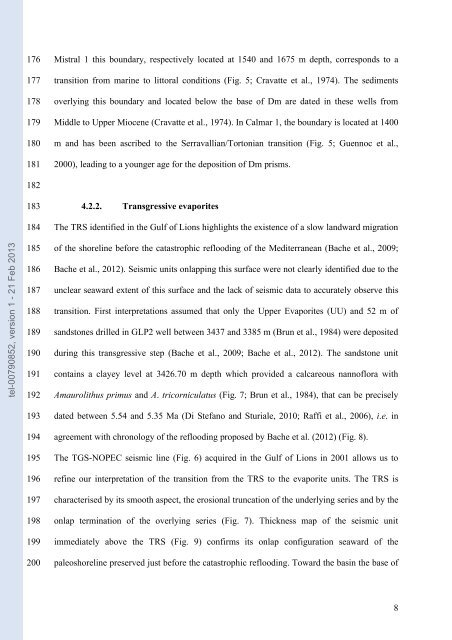Quantification des flux sédimentaires et de la subsidence du bassin ...
Quantification des flux sédimentaires et de la subsidence du bassin ...
Quantification des flux sédimentaires et de la subsidence du bassin ...
You also want an ePaper? Increase the reach of your titles
YUMPU automatically turns print PDFs into web optimized ePapers that Google loves.
tel-00790852, version 1 - 21 Feb 2013<br />
176<br />
177<br />
178<br />
179<br />
180<br />
181<br />
182<br />
183<br />
184<br />
185<br />
186<br />
187<br />
188<br />
189<br />
190<br />
191<br />
192<br />
193<br />
194<br />
195<br />
196<br />
197<br />
198<br />
199<br />
200<br />
Mistral 1 this boundary, respectively located at 1540 and 1675 m <strong>de</strong>pth, corresponds to a<br />
transition from marine to littoral conditions (Fig. 5; Cravatte <strong>et</strong> al., 1974). The sediments<br />
overlying this boundary and located below the base of Dm are dated in these wells from<br />
Middle to Upper Miocene (Cravatte <strong>et</strong> al., 1974). In Calmar 1, the boundary is located at 1400<br />
m and has been ascribed to the Serravallian/Tortonian transition (Fig. 5; Guennoc <strong>et</strong> al.,<br />
2000), leading to a younger age for the <strong>de</strong>position of Dm prisms.<br />
4.2.2. Transgressive evaporites<br />
The TRS i<strong>de</strong>ntified in the Gulf of Lions highlights the existence of a slow <strong>la</strong>ndward migration<br />
of the shoreline before the catastrophic reflooding of the Mediterranean (Bache <strong>et</strong> al., 2009;<br />
Bache <strong>et</strong> al., 2012). Seismic units on<strong>la</strong>pping this surface were not clearly i<strong>de</strong>ntified <strong>du</strong>e to the<br />
unclear seaward extent of this surface and the <strong>la</strong>ck of seismic data to accurately observe this<br />
transition. First interpr<strong>et</strong>ations assumed that only the Upper Evaporites (UU) and 52 m of<br />
sandstones drilled in GLP2 well b<strong>et</strong>ween 3437 and 3385 m (Brun <strong>et</strong> al., 1984) were <strong>de</strong>posited<br />
<strong>du</strong>ring this transgressive step (Bache <strong>et</strong> al., 2009; Bache <strong>et</strong> al., 2012). The sandstone unit<br />
contains a c<strong>la</strong>yey level at 3426.70 m <strong>de</strong>pth which provi<strong>de</strong>d a calcareous nannoflora with<br />
Amaurolithus primus and A. tricornicu<strong>la</strong>tus (Fig. 7; Brun <strong>et</strong> al., 1984), that can be precisely<br />
dated b<strong>et</strong>ween 5.54 and 5.35 Ma (Di Stefano and Sturiale, 2010; Raffi <strong>et</strong> al., 2006), i.e. in<br />
agreement with chronology of the reflooding proposed by Bache <strong>et</strong> al. (2012) (Fig. 8).<br />
The TGS-NOPEC seismic line (Fig. 6) acquired in the Gulf of Lions in 2001 allows us to<br />
refine our interpr<strong>et</strong>ation of the transition from the TRS to the evaporite units. The TRS is<br />
characterised by its smooth aspect, the erosional truncation of the un<strong>de</strong>rlying series and by the<br />
on<strong>la</strong>p termination of the overlying series (Fig. 7). Thickness map of the seismic unit<br />
immediately above the TRS (Fig. 9) confirms its on<strong>la</strong>p configuration seaward of the<br />
paleoshoreline preserved just before the catastrophic reflooding. Toward the basin the base of<br />
8

















